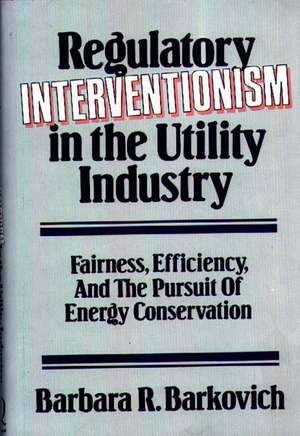Regulatory Interventionism in the Utility Industry: Fairness, Efficiency, and the Pursuit of Energy Conservation: Japanese Studies
Autor Barbara R. Barkovichen Limba Engleză Hardback – 31 mar 1989
During the 1970s and early 1980s utility regulators moved from largely unintrusive regulatory practices towards more aggressive and intrusive strategies. This study explores the reasons for the change and examines the trade-offs involved between seeking fairness to customers and efficiency of operations as primary goals of regulatory policies. An extended case study of the California Public Utilities Commission's conservation policies and utility programs from 1975 to 1984 is used to test theoretical explanations of interventionism. In a look toward the future of interventionist regulatory behavior, Barkovich concludes that in the future regulators will face more stringent limitations in pursuing certain forms of interventionism. "Business Information ALERT"
This pioneering study analyzes the changing nature of utility regulation in the United States, with particular emphasis on the 1970s and early 1980s when regulators moved from largely unintrusive regulatory practices toward more aggressive and intrusive strategies. Barkovich explores the reasons for this change in regulatory behavior and examines the trade-offs involved between seeking fairness to customers and efficiency of operations as primary goals of regulatory policies. Theoretical explanations of regulatory interventionism are then tested in an extended case study of the California Public Utilities Commission's (CPUC) conservation policies and utility programs from 1975 to 1984--widely cited as among the most active and creative in the nation.
Barkovich identifies three factors influencing regulatory decisionmaking--interest groups, the regulatory commission organization, and ideology--and proposes an extension of existing regulatory theory to explain interventionist behavior. Based upon an in-depth examination of the CPUC's policymaking, she demonstrates that regulatory interventionism has a number of prerequisites, among them factors which promote regulatory autonomy and reduce external constraints upon regulators. Finally, Barkovich looks toward the future of interventionist regulatory behavior in an increasingly market-oriented, service delivery system, concluding that, in the future, regulators will face more stringent limitations in pursuing certain forms of interventionism. Energy industry professionals, regulatory decisionmakers, and students of the utility industry and of government regulation of business will find important new insights into the social, political, and economic dynamics of utility regulation.
Preț: 345.74 lei
Preț vechi: 556.31 lei
-38% Nou
66.17€ • 68.82$ • 54.62£
Carte tipărită la comandă
Livrare economică 14-28 aprilie
Specificații
ISBN-10: 0899303838
Pagini: 181
Dimensiuni: 156 x 234 x 13 mm
Greutate: 0.45 kg
Editura: Quorum Books
Seria Japanese Studies
Descriere
This pioneering study analyzes the changing nature of utility regulation in the United States, with particular emphasis on the 1970s and early 1980s when regulators moved from largely unintrusive regulatory practices toward more aggressive and intrusive strategies. Barkovich explores the reasons for this change in regulatory behavior and examines the trade-offs involved between seeking fairness to customers and efficiency of operations as primary goals of regulatory policies. Theoretical explanations of regulatory interventionism are then tested in an extended case study of the California Public Utilities Commission's (CPUC) conservation policies and utility programs from 1975 to 1984--widely cited as among the most active and creative in the nation.
Barkovich identifies three factors influencing regulatory decisionmaking--interest groups, the regulatory commission organization, and ideology--and proposes an extension of existing regulatory theory to explain interventionist behavior. Based upon an in-depth examination of the CPUC's policymaking, she demonstrates that regulatory interventionism has a number of prerequisites, among them factors which promote regulatory autonomy and reduce external constraints upon regulators. Finally, Barkovich looks toward the future of interventionist regulatory behavior in an increasingly market-oriented, service delivery system, concluding that, in the future, regulators will face more stringent limitations in pursuing certain forms of interventionism. Energy industry professionals, regulatory decisionmakers, and students of the utility industry and of government regulation of business will find important new insights into the social, political, and economic dynamics of utility regulation.
















